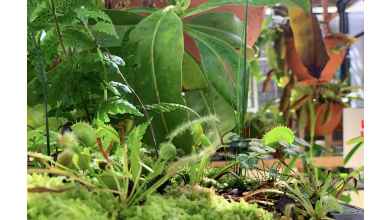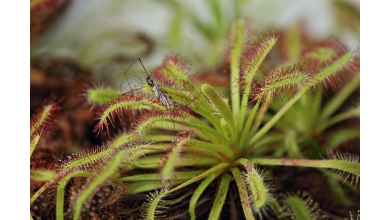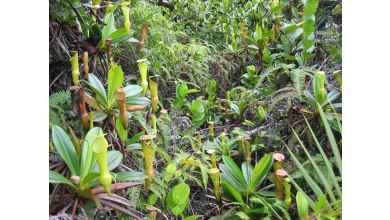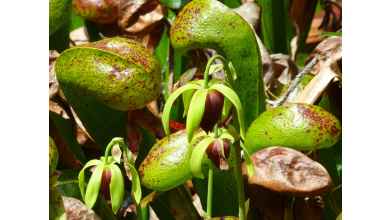Dionaea Muscipula (Venus Flytrap)

Dionaea Muscipula (Venus Flytrap)
Introduction
Dionaea muscipula, commonly known as Venus Flytrap, is a carnivorous plant species native to the wetlands of the southeastern United States. The plant is known for its unique and fascinating ability to capture and digest insects and small animals, making it a popular plant species for both scientific research and horticultural purposes. In this article, we will explore the anatomy, habitat, and cultivation of the Venus Flytrap.
Anatomy of Dionaea Muscipula
The Venus Flytrap is a small plant that grows up to 10-15 cm in height. It has a rosette of leaves that form a flat ground-hugging rosette. The leaves of the Venus Flytrap are divided into two parts: the petiole, which is a thin stalk that connects the leaf blade to the stem, and the blade, which is the part of the leaf that traps the prey.
The blade of the Venus flytrap has two lobes that are connected by a hinge-like structure called the midrib. The outer edges of the lobes are lined with small teeth called cilia, and the inner surface is covered with small, hair-like structures called trigger hairs. When an insect or small animal touches the trigger hairs, the lobes of the leaf snap shut, trapping the prey inside.
Habitat of Dionaea Muscipula
The Venus Flytrap is native to the wetlands of the southeastern United States, primarily in North and South Carolina. The plant grows in nutrient-poor soil and relies on insects and small animals for its nutrition. The Venus Flytrap can tolerate hot, humid summers and cold winters, making it a hardy plant that can survive in a range of environments.
Cultivation of Dionaea Muscipula
The Venus Flytrap is a popular plant species for both scientific research and horticultural purposes. Cultivating the plant requires specific growing conditions, including nutrient-poor soil, high humidity, and plenty of sunlight. The plant should be watered with distilled water or rainwater to avoid minerals that can harm the plant. The plant should be fertilised sparingly, as too much fertiliser can damage the plant's delicate root system.
The Venus Flytrap is a slow-growing plant that can take several years to reach maturity. The plant can be propagated by seed or through vegetative reproduction, such as leaf cutting or division. The plant is also susceptible to various pests and diseases, including spider mites, aphids, and fungal infections.
Uses of Dionaea Muscipula
The Venus Flytrap is primarily used for scientific research to study the plant's unique carnivorous adaptations. The plant is also a popular horticultural plant, and many cultivars have been developed for their unique colors and growth patterns. The plant is also used in traditional medicine for its anti-inflammatory and antispasmodic properties.
Propagation of Dionaea Muscipula
The Venus Flytrap can be propagated by seed or through vegetative reproduction. Seeds from the Venus Flytrap are relatively easy to grow, but they require specific growing conditions, such as warm temperatures and high humidity, to germinate successfully.
Vegetative reproduction is the process of growing new plants from existing plant parts, such as leaves or stem cuttings. This method is a popular way to propagate the Venus Flytrap, as it allows growers to produce identical plants with desirable traits.
Challenges of Growing Dionaea Muscipula
Growing the Venus Flytrap can be challenging, as the plant requires specific growing conditions to thrive. The plant requires a nutrient-poor soil that is high in organic matter, such as sphagnum moss or peat moss. The soil should be kept moist at all times, but not waterlogged, as this can cause root rot.
The Venus Flytrap also requires a high humidity environment, which can be achieved by placing the plant in a terrarium or by using a humidifier. The plant should be placed in a bright, sunny location, but should not be exposed to direct sunlight for extended periods, as this can damage the leaves.
Conclusion
In conclusion, the Venus Flytrap is a fascinating plant species that has captivated the imagination of people for centuries. The plant's unique carnivorous adaptations and striking appearance make it a popular plant for scientific research and horticultural purposes. However, growing the Venus Flytrap can be challenging, and requires specific growing conditions to thrive. If you're interested in growing this unique plant, be sure to research its specific growing requirements and provide the care that it needs to thrive.
Frequently Asked Questions (FAQs)
- What kind of insects do Venus Flytraps eat?
- The Venus Flytrap eats a variety of insects, including flies, ants, beetles, and spiders.
- How often should I water my Venus Flytrap?
- The Venus Flytrap should be watered with distilled water or rainwater about once a week, or when the soil feels dry to the touch.
- Can I feed my Venus Flytrap meat or other animal products?
- No, the Venus Flytrap should only be fed insects and small animals. Feeding the plant meat or other animal products can harm the plant.
- Can the Venus Flytrap harm humans or pets?
- No, the Venus Flytrap is not harmful to humans or pets. The plant's leaves are too small to trap anything larger than insects.
- Can the Venus Flytrap be grown indoors?
- Yes, the Venus Flytrap can be grown indoors in a terrarium or other high humidity environment. However, it is important to provide the plant with plenty of bright, indirect light to ensure that it grows and thrives.
Carnivorous Pitcher Plants May Lure Insects with Smell

Types of Carnivorous Plants

What Do Carnivorous Plants Eat?

Are There Any Carnivorous Plants in the UK?

How to Grow Venus Fly Trap from Seeds

Darlingtonia Californica Care Guide

